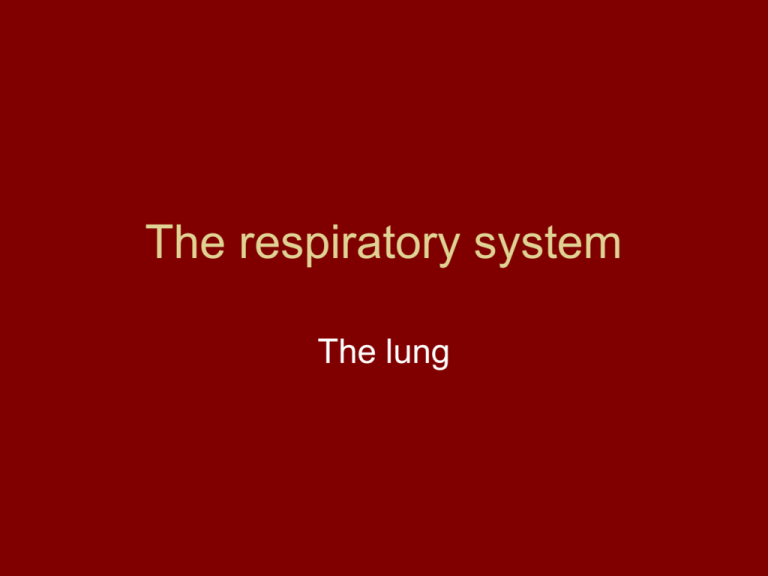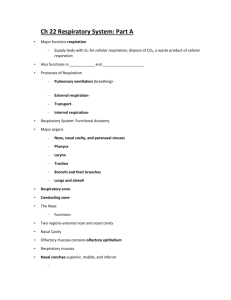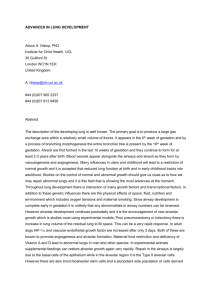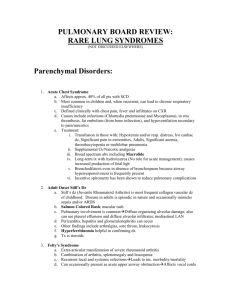The respiratory system
advertisement

The respiratory system The lung Normal lung structure • Function – gas exchange • Embryological developmental – from the ventral wall of the foregut . • The right lung bud eventually divides into three branches—the main bronchi—and the left into two main bronchi . • Three lobes on the right and two lobes on the left Normal lung structure • so the left lung is smaller than the right. The right main stem bronchus is more vertical and more directly in line with the trachea than is the left • So aspirated foreign material, such as vomitus, blood, and foreign bodies, tends to enter the right lung rather than the left. Normal lung structure • The main right and left bronchi branch , giving rise to progressively smaller airways • The lung have double arterial supply , the pulmonary and bronchial arteries. • Progressive branching of the bronchi forms bronchioles, which are distinguished from bronchi by the lack of cartilage and submucosal glands within their walls. Further branching of bronchioles leads to the terminal bronchioles, . The part of the lung distal to the terminal bronchiole is called the acinus. of normal structures within the acinus, the fundamental unit of the lung. A terminal bronchiole (not shown) is immediately proximal to the respiratory bronchiole. Normal lung structure • an acinus is composed of respiratory bronchioles (emanating from the terminal bronchiole), which give off several alveoli from their sides. These bronchioles then proceed into the alveolar ducts, which immediately branch into alveolar sacs, the blind ends of the respiratory passages, • A cluster of three to five terminal bronchioles, each with its appended acinus, is usually referred to as the pulmonary lobule Normal lung structure • From the microscopic standpoint, except for the vocal cords, which are covered by stratified squamous epithelium, the entire respiratory tree, including the larynx, trachea, and bronchioles, is lined by pseudostratified, tall, columnar, ciliated epithelial cells, heavily admixed in the cartilaginous airways with mucus-secreting goblet cells. Normal lung structure • The microscopic structure of the alveolar walls (or alveolar septa) consists, from blood to air, of the following . • The capillary endothelium lining the intertwining network of anastomosing capillaries. • • A basement membrane and surrounding interstitial tissue separating the endothelial cells from the alveolar lining Normal lung structure • Alveolar epithelium, which contains a continuous layer of two principal cell types: flattened, platelike type I pneumocytes (or membranous pneumocytes) covering 95% of the alveolar surface and rounded type II pneumocytes. Type II cells are important for at least two reasons: (1) They are the source of pulmonary surfactant, and (2) they are the main cell type involved in the repair of alveolar epithelium after destruction of type I cells. Normal lung structure • Alveolar macrophages, loosely attached to the epithelial cells or lying free within the alveolar spaces, derived from blood monocytes and belonging to the mononuclear phagocyte system. Often, they are filled with carbon particles and other phagocytosed materials. Microscopic structure of the alveolar wall. Note that the basement membrane (yellow) is thin on one side and widened where it is continuous with the interstitial space. Portions of interstitial cells are shown. Pathology • Primary respiratory infections, such as bronchitis and pneumonia, are common place in clinical and pathologic practice . • In these days of cigarette smoking, air pollution, and other environmental inhalants, chronic bronchitis and emphysema have become imporatnt and common disease . • malignancy of the lungs had been rising now a day . • Moreover, the lungs are secondarily involved in almost all forms of terminal disease, so some degree of pulmonary edema, atelectasis, or bronchopneumonia is present in virtually every dying patient Congenital Anomalies • Developmental defects of the lung include the following – • Agenesis or hypoplasia of both lungs, one lung, or single lobes – • Tracheal and bronchial anomalies (atresia, stenosis, tracheoesophageal fistula) – • Vascular anomalies – • Congenital lobar overinflation (emphysema) – • Foregut cysts – • Congenital pulmonary airway malformation – • Pulmonary sequestrations Atelectasis (Collapse) • Definition :_ Atelectasis refers either to incomplete expansion of the lungs (neonatal atelectasis) or to the collapse of previously inflated lung, producing areas of relatively airless pulmonary parenchyma. Acquired atelectasis, • it divided into resorption (or obstruction), compression, and contraction atelectasis ) 1-Resorption atelectasis • Definition :-is the consequence of complete obstruction of an airway, which in time leads to resorption of the oxygen trapped in the dependent alveoli, without impairment of blood flow through the affected alveolar walls. Since lung volume is diminished, the mediastinum shifts toward the atelectatic lung. • cause :- principally by excessive secretions (e.g., mucous plugs) or exudates within smaller bronchi and is therefore most often found in bronchial asthma, chronic bronchitis, bronchiectasis, and postoperative states and with aspiration of foreign bodies. 2-Compression atelectasis • atelectasis results whenever the pleural cavity is partially or completely filled by fluid exudate, tumor, blood, or air (the last-mentioned constituting pneumothorax) or, with tension pneumothorax, when air pressure impinges on and threatens the function of the lung and mediastinum, especially the major vessels. Compression atelectasis is most commonly encountered in patients with cardiac failure who develop pleural fluid and in patients with neoplastic effusions within the pleural cavities. Similarly, abnormal elevation of the diaphragm, such as that which follows peritonitis or subdiaphragmatic abscesses or occurs in seriously ill postoperative patients, induces basal atelectasis. With compressive atelectasis, the mediastinum shifts away from the affected lung 3-Contraction atelectasis • occurs when local or generalized fibrotic changes in the lung or pleura prevent full expansion . • Significant atelectasis reduces oxygenation and predisposes to infection. Because the collapsed lung parenchyma can be re-expanded, atelectasis is a reversible disorder (except that caused by contraction). Acute Lung Injury Acute Lung Injury • • • The term "acute lung injury" encompasses a spectrum of pulmonary lesions (endothelial and epithelial), which can be initiated by numerous factors. Susceptibility to lung injury appears to be heritable, and response and survival depend on the interaction of multiple loci on different chromosomes. Mediators include cytokines, oxidants, and growth factors, such as tumor necrosis factor (TNF), interleukin (IL)-1, IL-6, IL-10, and transforming growth factor (TGF)-β. Lung injury may manifest as congestion, edema, surfactant disruption, and atelectasis, and these may progress to acute respiratory distress syndrome or acute interstitial pneumonia. Each of these forms of pulmonary injury is described below. PULMONARY EDEMA • Pulmonary edema can result from hemodynamic disturbances (hemodynamic or cardiogenic pulmonary edema) or from direct increases in capillary permeability, owing to microvascular injury . 1-Hemodynamic Pulmonary Edema • The most common hemodynamic mechanism of pulmonary edema is that attributable to increased hydrostatic pressure, as occurs in leftsided congestive heart failure. • Grossly ;-congestion and edema are characterized by heavy, wet lungs. Fluid accumulates initially in the basal regions of the lower lobes because hydrostatic pressure is greater in these sites (dependent edema). • Histologically :- the alveolar capillaries are engorged, and an intra-alveolar granular pink precipitate is seen. Alveolar microhemorrhages and hemosiderin-laden macrophages ("heart failure" cells) may be present. In long-standing cases of pulmonary congestion, such as those seen in mitral stenosis, hemosiderin-laden macrophages are abundant, and fibrosis and thickening of the alveolar walls These changes not only impair normal respiratory function, but also predispose to infection. 2-Edema Caused by Microvascular Injury • The second mechanism leading to pulmonary edema is injury to the capillaries of the alveolar septa. Here the pulmonary capillary hydrostatic pressure is usually not elevated, and hemodynamic factors play a secondary role. The edema results from primary injury to the vascular endothelium or damage to alveolar epithelial cells (with secondary microvascular injury). This results in leakage of fluids and proteins first into the interstitial space and, in more severe cases, into the alveoli • When the edema remains localized, as it does in most forms of pneumonia, it is overshadowed by the manifestations of infection. When diffuse, however, alveolar edema is an important contributor to a serious and often fatal condition, acute respiratory distress syndrome, discussed in the following section. ACUTE RESPIRATORY DISTRESS SYNDROME (DIFFUSE ALVEOLAR DAMAGE) • Acute respiratory distress syndrome (ARDS) (synonyms include "shock lung," "diffuse alveolar damage," "acute alveolar injury," and "acute lung injury") is a clinical syndrome caused by diffuse alveolar capillary damage. It is characterized clinically by the rapid onset of severe life-threatening respiratory insufficiency, cyanosis, and severe arterial hypoxemia that is refractory to oxygen therapy and that may progress to extra-pulmonary multisystem organ failure. Chest radiographs show diffuse alveolar infiltration. Conditions Associated with Development of Acute Respiratory Distress Syndrome Infection Sepsis * Diffuse pulmonary infections * Viral, Mycoplasma, and Pneumocystis pneumonia; miliary tuberculosis Gastric aspiration * Physical/Injury Mechanical trauma, including head injuries * Pulmonary contusions Near-drowning Fractures with fat embolism Burns Ionizing radiation Inhaled Irritants Oxygen toxicity Smoke Irritant gases and chemicals Chemical Injury Heroin or methadone overdose Acetylsalicylic acid Barbiturate overdose Paraquat Hematologic Conditions Multiple transfusions Disseminated intravascular coagulation Pancreatitis Uremia Cardiopulmonary Bypass Hypersensitivity Reactions Organic solvents Drugs Morphology • In the acute stage, the lungs are heavy, firm, red, and boggy. They exhibit congestion, interstitial and intra-alveolar edema, inflammation, and fibrin deposition. The alveolar walls become lined with waxy hyaline membranes that are morphologically similar to those seen in hyaline membrane disease of neonates . Alveolar hyaline membranes consist of fibrin-rich edema fluid mixed with the cytoplasmic and lipid remnants of necrotic epithelial cells. Diffuse alveolar damage (acute respiratory distress syndrome) shown in a photomicrograph. Some of the alveoli are collapsed; others are distended. Many contain dense proteinaceous debris, desquamated cells, and hyaline membranes (arrows). Pathogenesis. • Acute lung injury occurs as a result of a cascade of cellular events initiated by either infectious or noninfectious inflammatory stimuli. An elevated level of pro-inflammatory mediators combined with a decreased expression of antiinflammatory molecules is a critical component of lung inflammation . • there is increased synthesis of IL-8, a potent neutrophil chemotactic and activating agent, by pulmonary macrophages. Release of this and other cytokines, like IL-1 and TNF, leads to pulmonary microvascular sequestration and activation of neutrophils. Neutrophils are thought to play an important role in the pathogenesis of acute lung injury and ARDS. Histological • examination of lungs early in the disease process has shown increased numbers of neutrophils within the vascular space, the interstitium, and the alveoli Thank you







